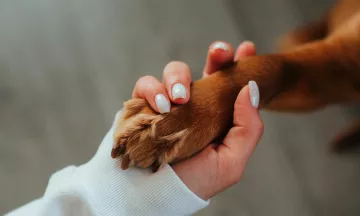Being alone makes dogs feel unsafe. They are pack animals by nature, and being in a group offers strength and protection. Being alone can therefore trigger emotional issues. No dog likes being alone, but for some it can cause major problems. Separation anxiety may develop at a young age, due to neglect for example. Yet it can also manifest later, after a particularly traumatic experience, such as their owner being away on holiday for a prolonged period, a house move or a rehoming exercise.
You can help prevent separation anxiety by getting your dog accustomed to being alone from an early age. Always start with just a few minutes at a time, and gradually build up to several hours. However, you should never leave your dog alone for an entire day - even dogs that don’t exhibit problematic behaviour are unhappier alone than in a group. If you regularly leave your home for prolonged periods, then arrange for a dog sitter to come and keep your four-legged friend company.
Dogs that are unaccustomed to being left alone from an early age sometimes go on to develop separation anxiety. It’s important therefore to recognise the symptoms and address the root cause of the problem..

Recognise the symptoms
Whining, barking, destroying furniture, self-harming, pacing and peeing in the home are typical symptoms of leaving anxiety. As are your dog’s refusal to eat or drink when alone, or his excessive excitement and hyperactivity upon your return. It’s important to be able to recognise these symptoms, especially if you happen to be a dog sitter! Sometimes a well-behaved dog will suddenly exhibit destructive behaviour or symptoms of stress. This can indicate separation anxiety and must therefore be tackled as such – it’s important to note that this type of behaviour is never intended to be 'bothersome'. So, whatever you do, don’t punish your dog for his actions, and instead reassure him.
Confidence
Whilst building up alone time is important, the key to success when it comes to separation anxiety is somewhat more complicated. Dogs that suffer from severe separation anxiety tend to lack self-confidence. This might be as the result of a traumatic experience for example. The secret trick to solving separation anxiety is to therefore rebuild their trust. They need to feel reassured that they are living in a warm 'nest' with a 'pack' that doesn’t abandon them. So, your number one priority is to provide that warm nest. Assign your dog a quiet place of refuge in the home, somewhere he feels safe and relaxed. And take him for plenty of long walks, engage in lots of play and generally shower him with affection.
Tired and content
Make sure that your dog is both tired and content before leaving him alone. Go for a long walk interspersed with plenty of play to expend his energy beforehand. Only leave your home once your dog is thoroughly calm and relaxed.
Check your own behaviour
Grabbing your keys, swapping your slippers for your shoes, dashing from one room to the next: you likely exhibit specific behavioural patterns when you’re preparing to leave your home. Your clever canine companion therefore thinks: Help! My pack leader’s leaving! So, try performing these same actions when you’re NOT about to leave the house: grab your keys, put your coat on and then simply stay at home. If you 'disassociate' your behaviour from your dog’s separation anxiety, his panic around your leaving will diminish. Only leave the house if your dog is totally relaxed and at ease.
If your dog tends to go overboard with excitement upon your return, then greet him in a calm, yet friendly manner. Make it clear that you’re happy to see him, yet avoid encouraging his hyperactivity. Never get angry with him, but instead reassure him and give him the trust that he craves.
Getting him accustomed to being alone
Dogs with severe separation anxiety must get used to your absences gradually. Disappear for short bursts throughout the day by going to another room and returning after a few minutes. Act like nothing’s wrong and reward your dog with a treat if he remains calm and relaxed. Keep repeating this until you actually leave your house for a short period. If your dog finds this too stressful, stop the exercise and begin the process again in a few days. Your dog must learn that being alone is nothing to be afraid of and that it’s not a punishment for any problematic behaviour. Again: it's about trust. And building a good rapport with your dog can really help.
Dog sitter
Dog sitters can be the ideal solution for providing your dog company when you’re not at home. However, there’s a catch.
Sometimes separation anxiety doesn’t only mean that your dog cannot be left alone; in some cases he simply cannot bear to be parted from you, his ‘pack leader’. Your dog may therefore become confused if he’s suddenly left with a someone 'new'. If you fail to introduce him to your dog sitter in the right way (by gradually building up feelings of security and trust), then it can prove a traumatic experience for him.
Make sure that you perform an intensive intake and get your dog thoroughly acquainted with his new dog sitter. Take him for a long walk with the dog sitter, and subsequently, explore the dog sitter’s home together. If you’ve arranged home boarding for your dog, then bring his favourite basket, blanket and other cherished items to make him feel at home. And, make sure that your chosen dog sitter showers your pampered pooch with as much love and affection as you do. That way he’ll rapidly feel confident and at ease in his company.
Note: If your dog suffers from acute separation anxiety, then it’s wise to engage the services of a dog behaviourist.





